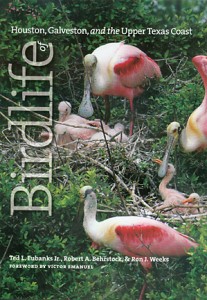In a world where money talks, the environment needs value to give it a voice.
Francis Cairncross
Birds are a critical component of this environment needing a voice. One way of speaking for birds is through studying, assessing, and quantifying the value of watching them. Will that alone protect them? No. There must be a holistic approach, including engagement, land conservation, scientific rearch, resource management, and policy implementation. But to ignore the economic value of birding is as nonsensical as hunters or anglers discounting their economic contributions, a mistake neither group makes. The consumptive wildlife recreations are fortunate in that there is an excise tax in the U.S. that funds conservation efforts. Without Pittman/Robertson or Wallup/Breaux (the Sportfish Restoration Act), few would care how much hunters and anglers spend. With birding and other wildlife viewing, the funding mechanism imperatives are missing.
Fermata has been involved in avitourism from the outset; in fact, Ted coined the term in an early paper on avitourism in High Island (linked below). Many of our projects have been product development, such as the birding and wildlife trails in Texas, Oklahoma, Oregon, Wisconsin, Alabama, Virginia, Pennsylvania, and elsewhere. But we have also been involved in some of the ground-breaking research of the recreation of birding, and Ted continues to publish on this topic.
Therefore we will begin with a few of our own (of course with valued coauthors, researchers, and friends). We are also providing links to the important macro-level surveys such as the USFWS, Outdoor Foundation, and the NSRE. These macro surveys differ widely, and the results, at times, appear far apart. However, remember that subtle differences in methodology and the phrasing of questions often impact results significantly. In our opinion all of these surveys are helpful, and each offers us a different view of what is a sizable population of people who find their way to nature through birds.
Books
Eubanks, T.L., R.A. Behrstock, and R. Weeks. 2006. Birdlife of Houston, Galveston, and the Upper Texas Coast. College Station: Texas A&M University Press.
Eubanks, T.L., R.A. Behrstock, and S. Davidson. 2008. Finding Birds on the Great Texas Coastal Birding Trail: Houston, Galveston, and the Upper Texas Coast. College Station: Texas A&M University Press.
Avitourism
High Island: A Case Study in Avitourism. Birding 25: pp. 415-420. Eubanks, T., P. Kerlinger and R. H. Payne, 1993.
Kerlinger, P., Eubanks, T., and Payne, R. H. The economic impact of birding ecotourism on the Santa Ana National Wildlife Refuge Area, Texas, 1993-1994. Report to US Fish and Wildlife Service, 1994.
Kerlinger, P., T. Eubanks, and R. H. Payne. The economic impact of birding ecotourism on the area surrounding the Laguna Atascosa National Wildlife Refuge, Texas. Report to National Fish and Wildlife Foundation and the US Fish and Wildlife Service. 1994.
Kerlinger, P. and T. Eubanks. Birds and bucks. Birding 27:21-23. 1995.
Kerlinger, P. and T. Eubanks. The economic impact of birding ecotourism on the Corkscrew Swamp Sanctuary (National Audubon Society) area, Florida, 1993-1994. Report to National Fish and Wildlife Foundation and National Audubon Society. 1995.
Kerlinger, P., T. Eubanks, and R.H. Payne. The economic impact of birding ecotourism on the Sabal Palm Grove Sanctuary (National Audubon Society) area, Texas, 1994-1995. Report to National Fish and Wildlife Foundation and National Audubon Society. 1995.
The Economic Impact of Wildlife Watching On the Platte River in Nebraska. Prepared for the U.S. Environmental Protection Agency Region VII. T. Eubanks, Ditton, R.B., Stoll, J. 1998.
Avitourism in Texas. Eubanks, T. and Stoll, J. R. Avitourism in Texas: Two studies of birders in Texas and their potential support for the proposed World Birding Center. Report to Texas Parks and Wildlife Department, contract #44467, 1999
Wildlife-associated Recreation on the New Jersey Delaware Bay Shore. Eubanks, T., J. Stoll, and P. Kerlinger). Contract New Jersey Fish, Game, and Wildlife, 2000.
A Survey of Two California Nature Festivals: the American River Salmon Festival, and the Kern Valley Biodiversity Festival. Fermata Inc. 2001.
Understanding the Diversity of Eight Birder Sub-populations: Socio-demographic Characteristics, Motivations, Expenditures and Net Benefits. Journal of Ecotourism Vol. 3, No. 3: pp. 151 – 172. Eubanks, T., J. Stoll, and R.B. Ditton, 2004.
America’s Wetland Birding Trail (Louisiana Coast) Concept and Development Plan, Fermata Inc., 2004.
Measuring Specialization Among Birders: Utility of a Self-Classification Measure among Birders: Utility of a Self-Classification Measure. Human Dimensions of Wildlife Vol. 10, Issue 1: pp. 53 – 74. Scott, D., R.B. Ditton, J. Stoll, and T. Eubanks, 2005.
Platte River Birding and the Spring Migration: Humans, Value, and Unique Ecological Resources. Human Dimensions of Wildlife Vol. 11: pp. 241–254. Stoll, J., R.B. Ditton, and T. Eubanks. 2006.
American Birders–Part I, Their Numbers and Outdoor Activity Profiles. A Recreation Research Report in the IRIS Series. Cordell, K., T. Eubanks, C. Betz, G. Green, B. Stephens, and S. Mou, 2008.
Popular Articles
Bare-naked Birding Birding, July/August 2007
Select blog posts by Ted
The I of a Bird (or Welcome to Birding! Now Get Out!
The Bird People (A Typology)
American the Beautiful
Inscrutable Whiteness
Toads in the Tureen
Birds without Birding

